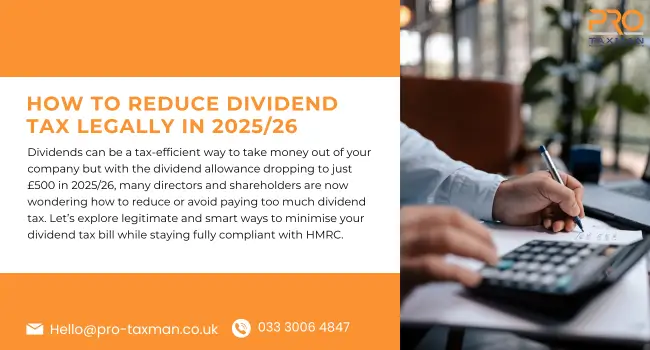Dividends can be a tax-efficient way to take money out of your company but with the dividend allowance dropping to just £500 in 2025/26, many directors and shareholders are now wondering how to reduce or avoid paying too much dividend tax.
Let’s explore legitimate and smart ways to reduce your dividend tax bill while staying fully compliant with HMRC.
1. Understand How Dividend Tax Works
Before you look for tax-saving strategies, it’s important to know how dividend income is taxed.
For the 2025/26 tax year:
- Dividend Allowance: £500 (tax-free)
- Basic Rate: 8.75%
- Higher Rate: 33.75%
- Additional Rate: 39.35%
Dividends are paid from profits after Corporation Tax, meaning they are not deductible business expenses. You only pay tax on dividends above your allowance, depending on your income tax band.
2. Use Your Personal Allowance
Everyone has a personal allowance of £12,570 (2025/26). If your only income is from dividends, the first £12,570 is completely tax-free.
By combining your personal allowance with the £500 dividend allowance, you can receive up to £13,070 in dividends before paying any tax.
Example:
- If you don’t take a salary, you could take £13,070 in dividends tax-free.
- If you take a small salary (say £12,570), you’d pay tax only on dividends above £13,070.
3. Split Income with Your Spouse or Partner
If your spouse or civil partner pays tax at a lower rate, you can transfer company shares to them (if appropriate). This allows both of you to:
- Use two sets of personal and dividend allowances, and
- Benefit from lower tax bands.
Example: If both partners have small salaries and own shares, together you could earn up to £26,140 in dividends tax-free (2 × £13,070).
4. Use an ISA (Individual Savings Account)
Dividends earned inside an ISA are completely tax-free no income tax, no dividend tax, and no capital gains tax.
In 2025/26, you can invest up to £20,000 per year into an ISA. Over time, this can build a large tax-free investment portfolio.
Tip: If you have spare cash, invest in dividend-paying shares within an ISA rather than your personal account.
5. Take a Mix of Salary and Dividends
Company directors can balance salary and dividends to stay within lower tax thresholds.
A common strategy:
- Take a salary up to the personal allowance (£12,570) or National Insurance threshold.
- Take the rest as dividends up to the basic rate limit (£50,270).
This helps minimise both Income Tax and National Insurance contributions, while optimising overall tax efficiency.
6. Use Your Company to Contribute to a Pension
Instead of paying more dividends (which could push you into a higher tax band), your company can make pension contributions on your behalf.
This is a tax-deductible business expense, reducing Corporation Tax, and the money grows tax-free inside your pension until you retire.
Example: A £10,000 pension contribution could save your company up to £1,900 in Corporation Tax (if the rate is 19%).
7. Consider a Family Investment Company (FIC)
If you have significant retained profits, you could consider setting up a Family Investment Company (FIC).
It allows you to:
- Invest company profits in assets like property or shares.
- Distribute dividends more flexibly among family members (e.g., children or spouse in lower tax bands).
This is a long-term strategy for wealth preservation and intergenerational planning.
8. Retain Profits in the Company
You don’t have to take all profits out as dividends.
If you leave profits in your company, you only pay Corporation Tax (currently 19% or 25%, depending on profits).
This defers personal tax and allows your company to reinvest, expand, or build reserves for future years when you might be in a lower tax bracket.
9. Plan the Timing of Dividends
If you expect your income to drop next year (e.g., due to lower business profits), it might be better to delay dividends until the next tax year when you’ll fall into a lower tax band.
Proper tax year planning can make a big difference to your total liability
10. Seek Professional Advice
Dividend taxation is complex and depends on your total income, shareholding structure, and future financial goals.
A qualified accountant can help you:
- Optimise salary-dividend mix,
- Identify allowable deductions,
- Handle family share transfers legally, and
- Keep HMRC-compliant.
Frequently Asked Questions (FAQs)
1. How much dividend is tax-free in 2025/26?
You can earn up to £500 tax-free under the dividend allowance, plus your personal allowance of £12,570 if you have no other income.
2. Do foreigners pay tax on UK dividends?
It depends on where you live.
- Non-residents don’t usually pay UK tax on dividends from UK companies, but your home country may tax them.
- Always check the Double Taxation Agreement (DTA) between the UK and your country.
3. How to avoid UK dividend tax?
You can’t avoid it completely, but you can reduce it by:
- Using your ISA for investments
- Taking a small salary and the rest as dividends
- Making pension contributions through your company
- Sharing income with your spouse
- Timing when you take dividends
4. Do I need to declare dividends under £500?
No if your total dividends are within the £500 allowance, you don’t need to report them to HMRC.
5. What’s better salary or dividends?
A mix of both is usually best. A small salary keeps your National Insurance record active, while dividends help reduce tax overall.
Final Thoughts
Dividend tax may feel unavoidable, but good planning goes a long way.
By making use of allowances, timing your withdrawals, and exploring smart options like ISAs and pensions, you can keep more of your hard-earned money.
If managing taxes feels confusing, don’t worry a professional accountant can help you make the most of your income without paying more than you need to.

